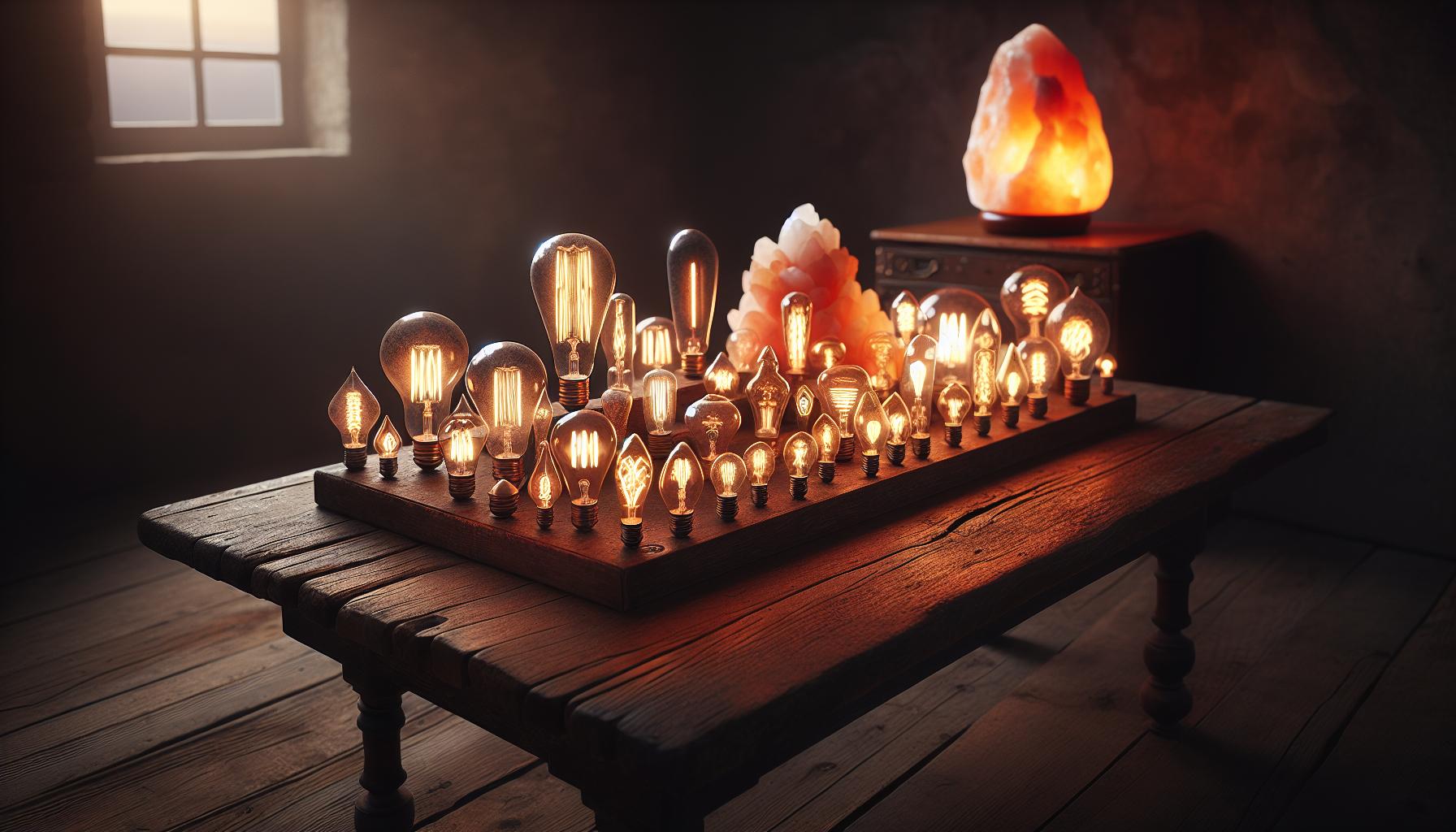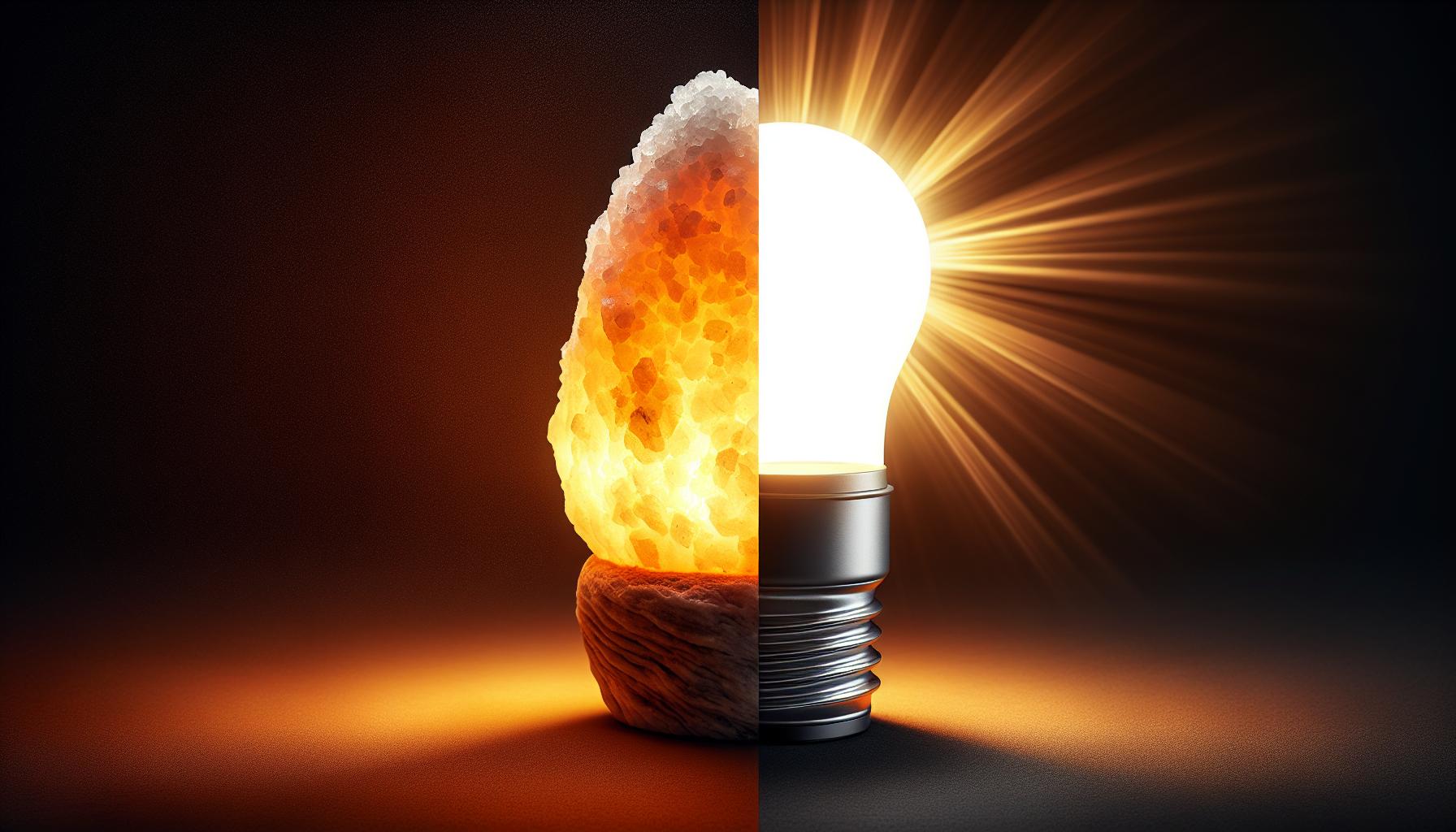Ever wondered what kind of light bulb your cozy salt lamp needs to keep glowing warm and bright? Choosing the right bulb isn’t just about the ambiance; it’s also about ensuring your lamp’s longevity and safety. With so many options out there, it’s easy to get lost in the wattage and base types.

Why the right light bulb matters for your salt lamp
When you’ve picked out the perfect salt lamp for your space, you’d think the hard part’s over, right? But here’s the kicker: your choice of bulb isn’t just a detail—it’s the heart of the matter. It’s like choosing the right fuel for your car; the right one will keep it purring, but the wrong one can lead to problems.
Consider this—the bulb’s warmth is what allows salt lamps to work their magic. A bulb that’s too powerful can cause your lamp to sweat excessively, which might lead to damage over time. On the flip side, a bulb that’s not warm enough won’t release the hygroscopic benefits of Himalayan salt, those that attract moisture from the air.
When mulling over light bulbs, you also have to ponder the ambiance. The warm glow of a salt lamp can transform a room into a sanctuary. So, you’d want a bulb that complements the lamp’s natural hue and contributes to a cozy atmosphere.
Safety is no joke, either. A bulb that’s the wrong size or wattage can overheat and pose a fire risk. That’s a big deal! Bulbs are like shoes in this sense – the right fit is essential; too big or too small, and you’re in for some trouble.
To the guts of it: the technicalities. There’s a middle-of-the-road approach that often works best. Typically, you’ll find that 15-watt bulbs are a good match for smaller salt lamps, while larger lamps may require a 25-watt bulb to effectively emit negative ions and light up your room adequately.
Here are the usual suspects when it comes to wattage and the size of your lamp:
| Bulb Wattage | Lamp Weight |
|---|---|
| 15 W | 1-6 lbs |
| 25 W | 7-11 lbs |
Understanding the basics: wattage and base types
When you’re selecting a light bulb for your salt lamp, understanding wattage and the base type is like knowing the difference between a relaxing evening and a safety hazard. Let’s start with wattage. The wattage of a light bulb indicates how much energy it uses and, consequently, how much heat it generates. Since a salt lamp works on the principle of attracting moisture from the air and then evaporating it, the right amount of heat is crucial.
Typically, salt lamp bulbs range from 15 to 40 watts. To find your sweet spot, consider the size of your salt lamp:
| Lamp Weight | Recommended Wattage |
|---|---|
| 2-3 lbs | 15 watts |
| 4-10 lbs | 25 watts |
| 11-20 lbs | 40 watts |
Heat is essential for your salt lamp to reap the hygroscopic benefits, but too much of a good thing can lead to over sweating and potential damage. Using the above guide helps you strike a balance.
Alongside wattage, the base type of the bulb ensures that you’ll actually be able to use it with your salt lamp. The most common base type for salt lamps is the E12 candelabra base. This smaller screw-in base is designed for nightlights, some decorative lights, and, of course, many salt lamps. Always double-check the base of your current bulb or your lamp’s specifications.
Making the Right Choice
It’s not just about functionality. Choosing the correct bulb base and wattage affects how your salt lamp illuminates your space. The glow should be warm and inviting, never too dim or overwhelmingly bright. Your lamp is a source of comfort and ambiance as much as it is a functional piece of decor.
In your quest for that perfect bulb, don’t forget that the build and longevity of the bulb matter. Look for bulbs that are advertised as specifically designed for salt lamps or ones that can handle high temperatures without faltering. Your salt lamp is there to light up your world for a long time, so make sure your bulb’s up for the job. And remember, prevention is better than cure: a well-chosen bulb reduces the risk of fire hazards and ensures your lamp functions as intended, keeping your evenings cozy and carefree.
Incandescent vs. LED: which is better for salt lamps?
« Is It OK to Spray Paint Light Bulbs? Safer Custom Light Tips Revealed
What Is the Best Light Bulb for Home Use? Illuminate Every Room Perfectly »
Diving into the debate between incandescent and LED bulbs for your salt lamp, you’ll want to consider their key differences. Each type affects the lamp’s ambiance and efficiency in its own way.
Incandescent bulbs are the traditional choice. They emit a warm, soft glow that perfectly complements the natural aesthetic of salt lamps. The heat produced by these bulbs is just right for stimulating the hygroscopic process, helping your salt lamp purify the air efficiently. However, they tend to have a shorter lifespan and consume more energy, which might nudge your utility bills a bit higher than you’d prefer.
On the other hand, LED bulbs stand out for their energy efficiency and longevity. If you’re prioritizing eco-friendliness and cost-effectiveness, LEDs are the way to go. But there’s a catch – they do not generate as much heat as incandescent bulbs, which could affect the air purifying ability of your salt lamp. Despite this, advancements in LED technology are bridging this gap, and you can now find high-heat LEDs designed with salt lamps in mind.
Here’s a quick comparison to help you decide:
| Feature | Incandescent Bulbs | LED Bulbs |
|---|---|---|
| Lifespan | Shorter | Longer |
| Energy Efficiency | Lower | Higher |
| Heat Emission | Higher | Varies |
| Cost Over Time | Higher | Lower |
| Eco-Friendly | Less | More |
When deciding between incandescent and LED bulbs for your salt lamp, factor in your personal preferences and the size of the lamp. Remember, salt lamps range in size and each size may require a different bulb to perform optimally. You might also want to think about the room where the lamp will be placed. If it’s a space where you spend a lot of time and desire a cozy, warm light, an incandescent bulb could be just what you need. However, if you’re looking for a bulb that’s touch-and-forget with minimal energy usage, LED is your friend.
Finding the right bulb for your specific salt lamp
Once you’ve weighed the pros and cons between incandescent and LED bulbs, it’s time to find the perfect match for your unique salt lamp. Size matters when selecting a bulb. Salt lamps vary in size from petite to quite hefty, and choosing a bulb that’s too small or too large can affect both the aesthetic and functionality of your lamp.
Start by checking the rating on your lamp’s power cord. You’ll usually find a wattage recommendation. Abiding by this guideline not only ensures proper illumination but also maintains safety standards.
For smaller lamps, you might find that a 15-watt bulb suffices, casting a gentle glow and ample heat. Larger lamps may require a bulb in the range of 25 to 40 watts to fully showcase their beauty and promote the hygroscopic effect.
To further tailor your lighting experience, consider the following:
- Brightness: Go for a higher lumen output for a brighter display or a lower one for a cozier atmosphere.
- Color Temperature: Incandescent bulbs generally provide a warm light, enhancing the lamp’s natural hues, while LEDs offer a wider range of color temperatures.
- Dimmability: Some salt lamps come with a dimmer switch, greatly expanding your lighting options. Ensure the bulb you choose is dimmable if you’d like this feature.
Here’s a succinct guide to help you compare bulb specifications for your salt lamp:
| Bulb Type | Suggested Wattage | Lumens | Color Temperature | Dimmable |
|---|---|---|---|---|
| Incandescent | 15-40 W | 120-410 lm | Warm white | Check packaging |
| LED | Equivalent wattage | Higher lumens | Various | Check packaging |
Remember, if you’ve got a large lamp, don’t be tempted to use a smaller bulb to save energy; it won’t heat the lamp properly and might leave you with a subpar experience. Conversely, a bulb that’s too powerful can cause the salt to sweat excessively, potentially damaging surfaces.
With these tips in hand, you’re well on your way to creating an ideal ambiance in your home. Embrace your inner DIY spirit, enlighten your space, and watch as your salt lamp transforms into both a source of light and a conversation piece.
Tips for maintaining and prolonging the lifespan of your salt lamp
You’ve found the perfect bulb for your salt lamp, and now you want to make sure it lasts. Proper maintenance not only prolongs its life but also ensures it continues to cast that warm, inviting glow in your space. Here are some expert tips to keep your salt lamp shining brightly:
Keep It Dry
Water is the enemy of salt lamps, as they are prone to melting when exposed to high humidity. It’s essential to keep them in dry areas and avoid any direct contact with water. If your home is particularly humid, using a dehumidifier can help preserve your lamp’s integrity.
Avoid Overexerting the Bulb
Using the correct wattage bulb is crucial, yet running your lamp for extended periods could shorten both the bulb’s and lamp’s lifespan. Try to give it a break after 7-8 hours of continuous use. This little breather can extend its life significantly.
Regular Cleaning
A simple dusting can go a long way. Use a damp cloth to gently clean the surface and immediately dry it with a lint-free cloth. This will prevent the salt from dissolving and keep your lamp dust-free.
Use a Quality Bulb Holder
Ensure the bulb holder and cord set are in good condition. A faulty holder can lead to electrical issues and, worse, shorten your bulb’s life. If you notice any wear or damage, it’s time to replace them.
- Make sure the cord does not show any exposed wiring.
- Check that the base is sturdy and can properly support the weight of the lamp.
Choose the Right Environment
Place your salt lamp in an area where it won’t be knocked over or exposed to drastic temperature changes. An environment that’s too warm could lead to a shortened bulb lifespan due to the increased energy demand.
Embracing these simple maintenance routines can make all the difference in extending the functional life of your salt lamp. Remember, it’s not just about the initial setup, but the ongoing care that counts. Keep these tips in mind and your salt lamp will continue to create a cozy atmosphere in your home for years to come.
Conclusion
Now that you’ve got the know-how selecting the perfect bulb for your salt lamp should be a breeze. Remember to keep an eye on size and wattage to ensure a snug fit and proper illumination. By embracing the right maintenance habits your salt lamp will not only last longer but also continue to enhance the ambiance of your space. So go ahead and bask in the warm glow of your well-cared-for salt lamp confident in the choices you’ve made. Happy lighting!
Frequently Asked Questions
What size bulb should I use for my salt lamp?
Choose a light bulb that fits the size of your salt lamp. Generally, smaller lamps need smaller bulbs while larger salt lamps require larger bulbs to effectively illuminate the lamp.
What is the recommended wattage for my salt lamp bulb?
Check the wattage recommendation usually listed on the salt lamp’s power cord. It’s crucial to match the bulb’s wattage with the lamp’s rating to prevent overheating and potential damage.
Are there different brightness levels available for salt lamp bulbs?
Yes, salt lamp bulbs come in various brightness levels. Consider how much light you want your lamp to emit when selecting the bulb’s brightness.
How does color temperature affect my salt lamp?
Color temperature can influence the ambiance of the room. Warmer color temperatures (orange/yellow) typically enhance the natural glow of salt lamps, contributing to a cozy atmosphere.
Should I opt for a dimmable salt lamp bulb?
If you want to adjust the brightness of your salt lamp to suit different times of the day or to create a specific mood, choosing a dimmable bulb is beneficial.
How can I maintain and prolong the lifespan of my salt lamp?
To maintain your salt lamp, keep it dry, avoid overexerting the bulb by using the correct wattage, clean it regularly, utilize a quality bulb holder, and choose the right environment that’s free from excessive moisture.
What are the potential consequences of using the wrong bulb for my salt lamp?
Using the wrong bulb can lead to insufficient illumination, overheating, or even damage to your salt lamp. It’s important to adhere to the manufacturer’s recommendations for the best results and safety.




